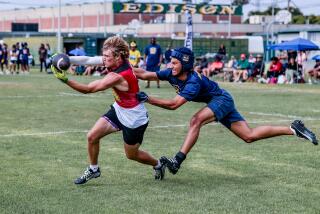San Fernando Mission Prepares for Children of Video Age
The San Fernando Mission, whose 35,000 visitors each year are mostly schoolchildren, was bracing for the first busload of pupils in the new school year.
Building toward a grimace, Msgr. Francis J. Weber said that as mission administrator he wants to provide a meaningful 75-minute tour for Los Angeles fourth-graders studying California history.
âBut sometimes we have to ask the kids to leave because theyâre bothering the fowl or breaking the flowers,â he said. âA third of the teachers sit in the bus or in the park across the street while the kids tear up the place.â
What was different this September was the unveiling of a small movie theater, the first-ever audiovisual feature within a musty museum where exhibits lean toward the static and unpretentious.
With money from the Fritz Burns Foundation, the mission used laser discs to record three existing films on Catholic history. Visitors to the new El Teatro de Junipero Serra make their choice by pushing one of three buttons near a four-foot-square screen.
âThe room is kid-proof,â Weber quickly noted. âWe have unbreakable glass in front of screen and you canât jam the buttons.â
Adult tourists seem to like it, said Weber, longtime historian and archivist for the archdiocese. âThe movies are going on every time I look in.â
Nevertheless, he admitted that fourth-graders are likely to fidget if they choose either of the two longer presentations: a 29-minute film on Father Serra, the 18th-Century founder of the California mission system, or a 24-minute show on mission history. Weber wrote the script on the latter in the early 1960s and plans to revise and shorten it.
More engaging is a 12-minute movie showing the history of the archdiocese and employing special effects and several film clips.
Waiting inside the gift shop-mission entrance for the children to arrive, Weber pointed impishly to the wall over the cashierâs area. A large, framed cartoon depicts a gun-toting preacher saying, âSmoke and Iâll shoot your ash off!â Weber said it was drawn by artist Andy Dagosta, a fellow western history buff. In a gift shop crammed with rosaries, religious medals and statues, he said with a smile, the cartoon has prompted some indignant âReal-ly, Fatherâ remarks.
Just then, out of a yellow bus poured 42 youngsters--second-graders to high school students--from Ability Plus School in Woodland Hills. Several wore the schoolâs âA+â T-shirts.
Weber was visibly relieved.
âThese are high-achievers, arenât they?â he asked the teacher, Carol Loweree. She nodded yes. It turned out that this was âmissions weekâ at the private, non-sectarian school. The group was traveling later in the week to the San Gabriel and Santa Barbara missions.
Weber slipped back to his office. Since none of the missionâs volunteer docents had been lined up to lead the tour, curator Kevin Feeney stepped in.
Feeney guided the students through two rooms of exhibits, but it wasnât until they went outside that the younger ones became excited. âWhoa . . . holy smoke!â They had spotted the several pheasantlike peafowl on the grounds.
The group eventually filed into the 233-foot-long building known as the convento. In one room, Feeney stood before a pipe organ he said was 200 years old. âWow,â said James Moore, a 9-year-old clutching a feather he picked up outside.
âCan you play it?â one boy asked. âYou can, but you wonât get any sound,â the curator responded.
Feeney was peppered with questions in each artifact-filled room. Finally, he led them into the new theater where the kids settled into the movable, hard-plastic chairs.
Responding to a question, Feeney said historians donât know what the room was used for originally. He did say it âis immediately above an old wine cellar. . . .â
âIs there any wine down there?â asked Jesse Decrescenzo, 14.
âThere are wine barrels, but no wine,â Feeney said.
The teacher chose the mission history film. As might be expected, it speaks in highly favorable terms of the âcivilizingâ of the Indians by the mission fathers and attributes the suffering by Indians at the end of the 40-year mission period to the sudden âsecularizationâ of the missions by Mexico.
The film was heavy on minutiae. And words such as discernible, replica, expectant, paleontologist, annals and canonically appeared in the narration by veteran radio announcer Thomas Cassidy.
Several youngsters stretched and squirmed. The bus driver dozed off.
However, Dharma Wright, 13, insisted afterward: âI thought it was cool. I liked it.â Shawn Thorburn, 10, conceded, âThere was at least five words I didnât understand.â
Johanna Sweigart, 11, added confidently, âWeâll âclear themâ later.â
At the gift shop, where the children could buy souvenirs before leaving, teacher Loweree explained that the students later will discuss words that they didnât understand. âWeâll go to a dictionary, talk about the definitions and âclear them,â â Loweree said.
As the Ability Plus youngsters left, ending a well-behaved but probing two-hour stay, cashier Mary Shaw teased the curator-turned-guide, âYour eyes have that glazed look.â
âI havenât done that for four years, since I left teaching,â Feeney said.
More to Read
Sign up for Essential California
The most important California stories and recommendations in your inbox every morning.
You may occasionally receive promotional content from the Los Angeles Times.










